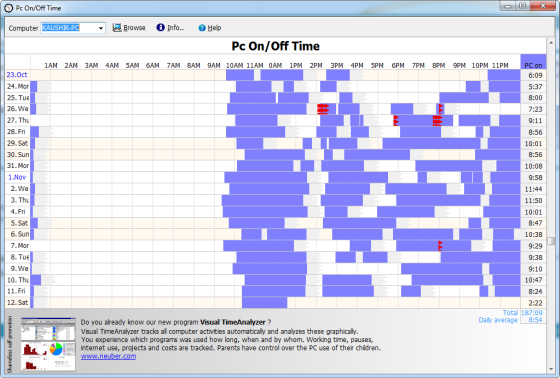PC On/Off Time is an easy-to-use program which graphically displays when your PC was turned on, shutdown or gone into standby for up to the last three weeks. This data is readily available from Windows Event log that contain records of all events and problems that a computer encounters, including software installs and uninstalls, system crashes and system shutdown. While the data is already there, it is not easy to see because the Event Log Viewer is one of the most horribly designed Windows program. This is why I suggested readers to use EventLog Inspector. PC On/Off Time is an entirely different tool though.
PC On/Off Time will display when the computer was running and when it was turned off in a calendar like view. The blue bars indicate the period of the day when the computer was on. The red bar indicates that the computer was shut down unexpectedly with a following reboot. The grey fade-out indicates that the computer switches into standby mode.

You can actually see your work cycle from the graph. It also provides an easy way to check up on others. For instance, you can know when your kids are really using their PC. If your PC is on a network, it is also possible to view uptime of a remote PC provided you have the necessary permissions.
The best thing about PC On/Off Time is that the program doesn’t need to be constantly running in the background to record all this information. As already explained, this data is recorded by Windows and available on the PC’s event log. In fact you don't have to install anything at all, as PC On/Off Time is portable.
The free version of PC On/Off Time limits the reports to last 3 week. The Pro version has no time limit and in addition includes automatic backup of event logs so that you can view past reports even though the original event logs were deleted.
[via PC Advisor]

Comments
Post a Comment